Moisture Transmission
Solving Moisture Transmission and Other Moisture Problems
The most common method for evaluating the moisture vapor diffusion rate of a building material is ASTM E-96 (Standard Test Method for Water Vapor Transmission of Materials). E-96 determines the "water vapor permeance" for a given material at a given thickness. The permeance is often referred to as the "Perm rating"; the higher the Perm rating, the faster the diffusion rate of water vapor through the material.
While some of the best quality products may approach the concept of being barriers, all offerings have permeance ratings. All offerings pass some measurable amount of moisture vapor. Unfortunately and too often construction specifications regarding these materials call for "Visqueen" or simply require 6-mil plastic. VisQueen is a trademark of the Tredegar Corporation and they no longer manufacture sheet plastic for use as in ground moisture vapor retarders beneath concrete slabs.
Concrete Moisture Vapor Transmission (MVT)
Excessive concrete moisture vapor emission is known to cause distress or failure of floor covering and coating systems. Most manufacturers of floor covering materials and adhesive systems have stated limits of tolerable concrete moisture content or vapor emission volume (2-4 lbs / 1,000 sq ft / 24 hrs) and concrete surface pH levels. While pH levels are primarily controlled by factors within the concrete, moisture vapor emission is not.
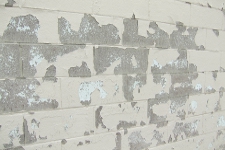 |
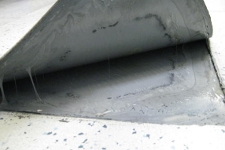 |
| Paint Peeling from Block | SVT Tile Delaminating from Slab |
The first potential moisture source is the concrete itself. Construction schedules rarely contain sufficient time to facilitate natural drying of concrete. An old "rule-of-thumb" exists that suggests allowing one month of drying per inch of slab thickness, under ideal conditions. The ideal ambient conditions are a minimum temperature of 70° F, maximum 30% relative humidity and constant air movement at 15 m.p.h. Neither "rule" accounts for mix design water/cement (W/C) ratio that will dramatically impact the required dry time. In his 1965 study entitled "Moisture Migration – Concrete Slab-On-Ground Construction" H.W. Brewer tracked moisture outflow of concrete as it dried. His study shows that a high W/C concrete takes longer to achieve low level outflow than drier mix designs.
ICD & MVT
Having tested for MVT using a plastic sheet (ASTM D 4263), the calcium chloride test (ASTM F 1869), or the most current and accepted relative humidity testing (ASTM F2170) with RH probes, you are now armed with information as to concrete moisture condition.
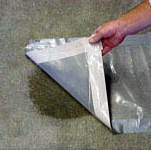 |
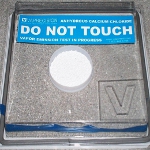 |
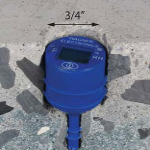 |
|
ASTM D 4263 |
ASTM F 1869 | ASTM F2170 |
While moisture vapor can be reduced and controlled using ICD integral admixtures and systems, sometimes combined with others, it is more common that a post-construction problem MVT is found either just prior to application of concrete finshes or at some later date. Just as ground water and surface water conditions change, so too does MVT in response when adequate control measures are not present.
The ideal is to have a slab with an average relative humidity below 75%. This however does not speak to the variability of MVT. Readings can vary considerably in a single continuous slab. ICD topical treatments can be used to reduce MVT by penetrating into the concrete and reacting with residual hydration products contained within the pore structure. Re-hydration of dormant particles in effect further restricts the permeability of the concrete. Proper preparation and application of ICD treatments can be a most cost effective method of remediation when compared with surface coatings that themselves remain subject to both the MVT and concrete pH.
Promotions
 Would your company like to work with us? Contact Us to learn more about our joint venture program and cross-promotion opportunities.
Would your company like to work with us? Contact Us to learn more about our joint venture program and cross-promotion opportunities.







